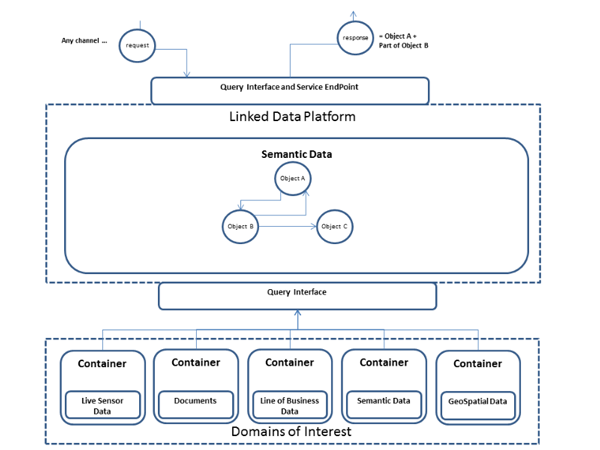Lift your work rate using Linked Data
There are many businesses and governments around the world that are embracing data as an asset. But what does this mean? Data is integral to understanding business operations and to support business planning. It is important that data is accessible, discoverable and managed by responsible and accountable members within an organisation.
In today’s digital world, there are enormous amounts of data produced by sensors and systems. There is data that is open for public access “Internet of Things” and data that is private and protected based on organisation considerations. The world is producing an enormous amount of “Big Data”. This problem poses an insightful question. How can data be open to systems and users so that it can be accessible and discoverable in a simple way?
The term Open Linked Data is concept that supports an enterprise and holistic view and helps with solving this problem. Open Linked Data published as a service (LDaaS) supports the on-demand access to data regardless of the physical, geographical or organisational separation between the Linked Data provider and the consumer. It can help decouple an application from the data and consequently contributes to the reusability of data in differing contexts and applications.
What does it mean to an organisation?
Many organisations invest in complex and significantly costly programs and projects to enable data mapping and integration from various systems. These costs can be significantly reduced from an initial capital investment and on-going operational investment.
LDaaS aims to leave systems alone by enabling Semantic Interoperability. Production and Operational support systems are structured and changes to these data structures for 1 or 2 fields can be costly. Downstream Business Intelligence and Data Warehousing are impacted in the same way.
Unstructured data such as spreadsheets are highly flexible to users; however, data integrity is comprised. A user can’t be 100% comfortable that data used within a spreadsheet is accurate. The relevance of data is based on a point in time. GeoSpatial Data (location data) is contained within various systems (i.e. address data) and is typically duplicated in a non-standard way.
Simplification of complex data exchanges will reduce organisational complexity and costs. This does require a paradigm shift for an organisation. The organisation must invest in a semantic model to support its supply chain operations.
Once this model is developed and deployed the cost for change to this model is low. There is no impact to existing systems.
An introduction of a semantic model would improve discoverability and access to data via a standard interface. For example, if you want to know an address of a supplier entity, a user or system would query the supplier address data object and retrieve this from one endpoint. This is an alternative to the address information of a supplier being contained in various systems.
What are the benefits?
The benefits are drawn from existing business models at varying maturity stages of LDaaS.
- Efficiency gains in data integration – the network effect
- Increased linking and integrated services
- Ease of model updates
- Ease of navigation (user and system discoverability and access)
- Enthusiasm from ‘champions’
- Flexible data integration
- Increase in data quality
- Cost reduction

This concept diagram demonstrates LDaaS’ capability. Data is accessed from data domains through the linked data platform. A user or system can query a semantic object.
Manufacturing application
Think of Linked Data as a distributed network such as a supply chain network in a manufacturing organisation. Each piece of equipment (fixed plant) has an operational responsibility to achieve the desired throughput for the whole of the system. Typically, a piece of equipment can be queried to understand the operational statistics. A local hardware interface or an application can visualise operational statistics.
The development of a Semantic Model that mirrors the organisations supply chain allows for discoverability of equipment as a semantic object. A user or system can navigate to other equipment dependencies. This can ultimately lead to discovering bottlenecks within the supply chain. Data Analytics tools such as Tabeau, Spotfire etc. can query each component in the network to analyse data.
 Rick Ross is an Enterprise Architect at an Australian Government agency supporting business to government (B2G) and Government and Government-to-Government (G2G) Data Sharing and Data Discovery. Email rick@rossinnovationgroup.com.au
Rick Ross is an Enterprise Architect at an Australian Government agency supporting business to government (B2G) and Government and Government-to-Government (G2G) Data Sharing and Data Discovery. Email rick@rossinnovationgroup.com.au
